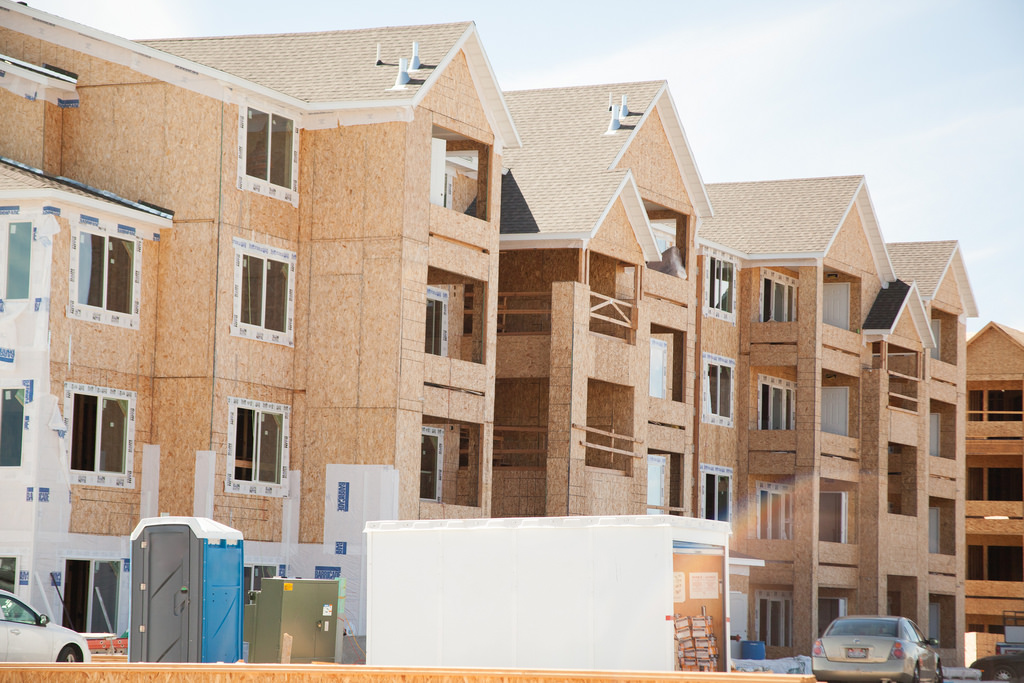Predictions that multifamily housing construction would taper off in 2015 may have underestimated the ongoing demand for this kind of housing, the vast majority of which is being marketed as rentals.
Seasonally adjusted annualized starts for structures with five or more units rose to 476,000 in June, an 18-year high, according to Commerce Department estimates released a few days ago. That number was 28.6% higher than the annualized multifamily starts rate in May, and 55% higher than the comparable number in June 2014.
Perhaps more significant is the fact that multifamily continues to propel most of the housing sector’s current growth. While annualized single-family starts in June, at 685,000 units, were 14.7% ahead of June 2014, they actually declined by 0.9% compared to May 2015.
“The multifamily gains this month are encouraging and show that the millennial generation continues to be drawn to the rental market,” said Tom Woods, a home builder from Blue Springs, Mo., who is chairman of the National Home Builders Association (NAHB).
All told, the year-over-year annualized rate for all starts was up 26.6% in June to 1,174,000 units.
The NAHB/Wells Fargo Housing Market Index, which tracks Builder Confidence levels, hit 60 in July. The Index also revised its June level to 60. The last time this Index got this high was November 2005.
If permit activity is a gauge of future optimism about demand, builders remain solidly behind multifamily. The annualized rate in June for permits issued for structures five or more units was up 79% to 621,000 units, compared to June 2014. Single-family permits, on the other hand, were up 6% to 687,000, according to Commerce’s estimates. All told, annualized new-home building permits jumped 30% to 1,343,000.
The latest annualized data show that 500,000 structures with five or more units were under construction in June, 20.5% more than in June 2014; and 317,000 units were completed, a 17.9% gain.
David Crowe, NAHB’s chief economist, noted that while the starts and Builder Confidence numbers were positive signs, he cautioned that builders “still face a number of challenges, including shortages of lots and labor.”
Related Stories
Office Buildings | Jun 28, 2023
When office-to-residential conversion works
The cost and design challenges involved with office-to-residential conversions can be daunting; designers need to devise creative uses to fully utilize the space.
Multifamily Housing | Jun 28, 2023
Sutton Tower, an 80-story multifamily development, completes construction in Manhattan’s Midtown East
In Manhattan’s Midtown East, the construction of Sutton Tower, an 80-story residential building, has been completed. Located in the Sutton Place neighborhood, the tower offers 120 for-sale residences, with the first move-ins scheduled for this summer. The project was designed by Thomas Juul-Hansen and developed by Gamma Real Estate and JVP Management. Lendlease, the general contractor, started construction in 2018.
Affordable Housing | Jun 27, 2023
Racial bias concerns prompt lawmakers to ask HUD to ban biometric surveillance, including facial recognition
Two members of the U.S. House of Representative have asked the Department of Housing and Urban Development to end the use of biometric technology, including facial recognition, for surveillance purposes in public housing.
Apartments | Jun 27, 2023
Average U.S. apartment rent reached all-time high in May, at $1,716
Multifamily rents continued to increase through the first half of 2023, despite challenges for the sector and continuing economic uncertainty. But job growth has remained robust and new households keep forming, creating apartment demand and ongoing rent growth. The average U.S. apartment rent reached an all-time high of $1,716 in May.
Apartments | Jun 27, 2023
Dallas high-rise multifamily tower is first in state to receive WELL Gold certification
HALL Arts Residences, 28-story luxury residential high-rise in the Dallas Arts District, recently became the first high-rise multifamily tower in Texas to receive WELL Gold Certification, a designation issued by the International WELL Building Institute. The HKS-designed condominium tower was designed with numerous wellness details.
Multifamily Housing | Jun 19, 2023
Adaptive reuse: 5 benefits of office-to-residential conversions
FitzGerald completed renovations on Millennium on LaSalle, a 14-story building in the heart of Chicago’s Loop. Originally built in 1902, the former office building now comprises 211 apartment units and marks LaSalle Street’s first complete office-to-residential conversion.
Urban Planning | Jun 15, 2023
Arizona limits housing projects in Phoenix area over groundwater supply concerns
Arizona will no longer grant certifications for new residential developments in Phoenix, it’s largest city, due to concerns over groundwater supply. The announcement indicates that the Phoenix area, currently the nation’s fastest-growing region in terms of population growth, will not be able to sustain its rapid growth because of limited freshwater resources.
Multifamily Housing | Jun 15, 2023
Alliance of Pittsburgh building owners slashes carbon emissions by 45%
The Pittsburgh 2030 District, an alliance of property owners in the Pittsburgh area, says that it has reduced carbon emissions by 44.8% below baseline. Begun in 2012 under the guidance of the Green Building Alliance (GBA), the Pittsburgh 2030 District encompasses more than 86 million sf of space within 556 buildings.
Industry Research | Jun 15, 2023
Exurbs and emerging suburbs having fastest population growth, says Cushman & Wakefield
Recently released county and metro-level population growth data by the U.S. Census Bureau shows that the fastest growing areas are found in exurbs and emerging suburbs.
Engineers | Jun 14, 2023
The high cost of low maintenance
Walter P Moore’s Javier Balma, PhD, PE, SE, and Webb Wright, PE, identify the primary causes of engineering failures, define proactive versus reactive maintenance, recognize the reasons for deferred maintenance, and identify the financial and safety risks related to deferred maintenance.

















